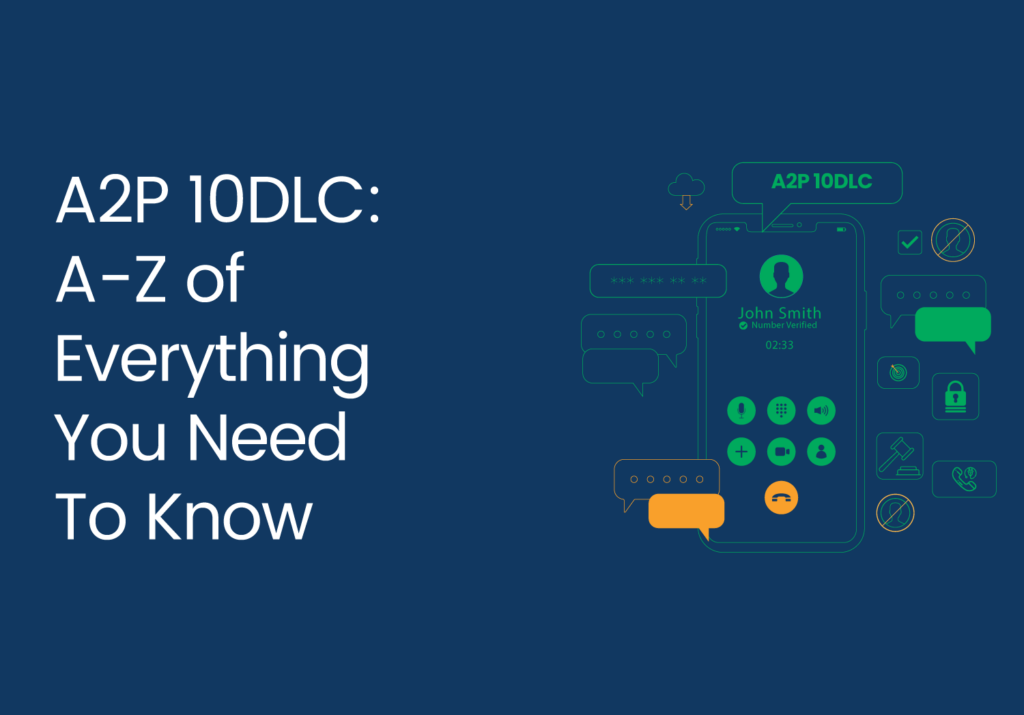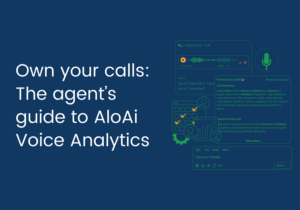There are many ways to reach potential customers without bothering them and getting your business number blocked.
As a business owner, finding the right balance between promoting your products or services and respecting your target audience’s boundaries is essential.
Being too aggressive without prudent measures can deal terrible blows to your business, driving customers away and earning you heavy fines from the Federal Communications Commission (FCC).
Because being on the wrong side of customers doesn’t benefit your business, it is essential to understand A2P 10DLC and how it impacts your business or contact center operations.
No, A2P 10DLC isn’t a new Star Wars droid or a fancy car model. 😀
This article will explain everything you need to know and why it’s essential for your business.
Here are the highlights of the article for your navigation.
Table of Contents
What is A2P 10DLC?
A2P 10DLC stands for Application-to-Person (A2P) 10 Digit Long Code (10 DLC).
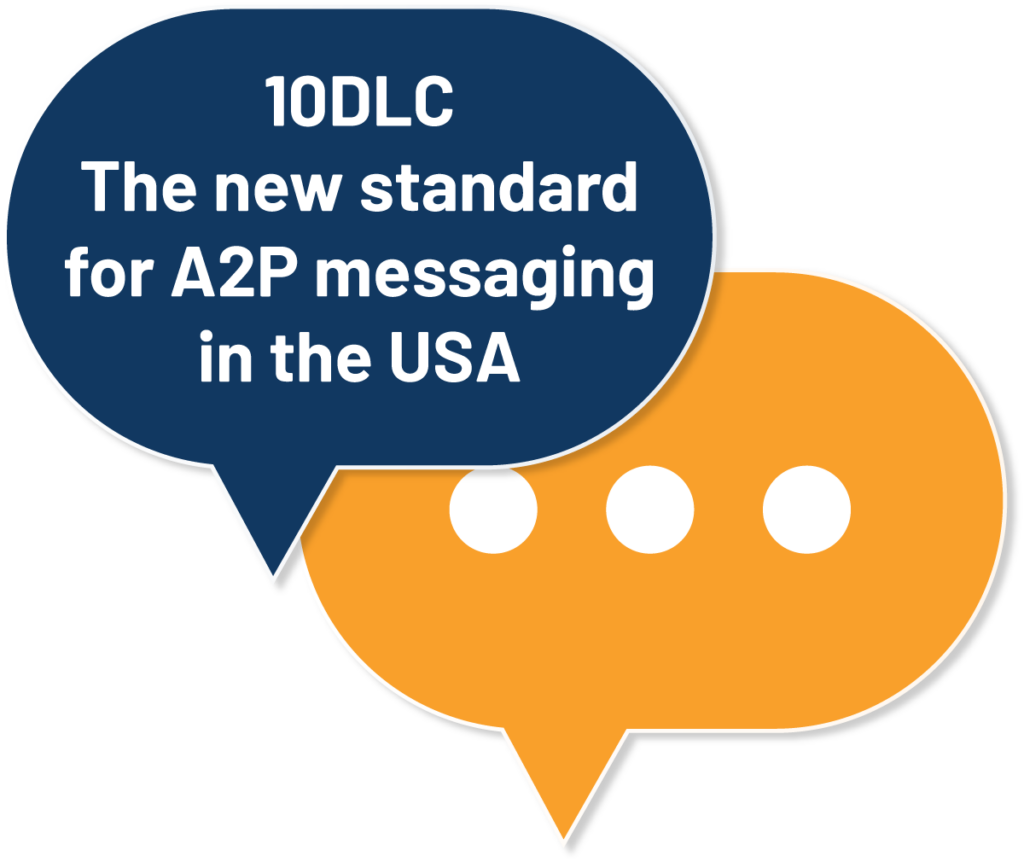
It is a system that allows your business to send text messages to customers using regular phone numbers, similar to how you and I send and receive personal text messages.
It is part of a broader know-your-customer effort to improve consumer trust and increase the returns of businesses through messaging.
Traditionally, businesses sent automated SMS messages using shortcodes (5 or 6-digit numbers). However, that is changing as long codes are becoming a popular choice for businesses.
With A2P 10DLC, businesses can easily leverage regular 10-digit phone numbers for their messaging needs. This makes it easier to reach customers and engage with them more meaningfully.
What is A2P 10DLC Compliance?
A2P 10DLC compliance ensures that SMS messages sent through 10-digit long codes (regular phone numbers) comply with industry regulations, carrier requirements, and best practices.
It was set forth by US carriers (such as AT&T, T-Mobile, Verizon, etc.) to regulate the application-to-person (A2P) type messaging via standard 10-digit long code (10DLC) phone numbers.
The rule requires your business or organization to register the brand, phone number, and use case of campaigns with carriers before sending A2P messages using 10DLC numbers.
By following the A2P 10DLC compliance, businesses can build stronger customer relationships, maintain positive carrier relationships, and deliver their messaging campaigns reliably while upholding industry standards.
So,
Why A2P 10DLC?
Spam texts have become an increasing challenge in the US, with billions of such texts sent every year.
Americans received 87.8 billion spam text messages in 2021, a 58% increase from the previous year.
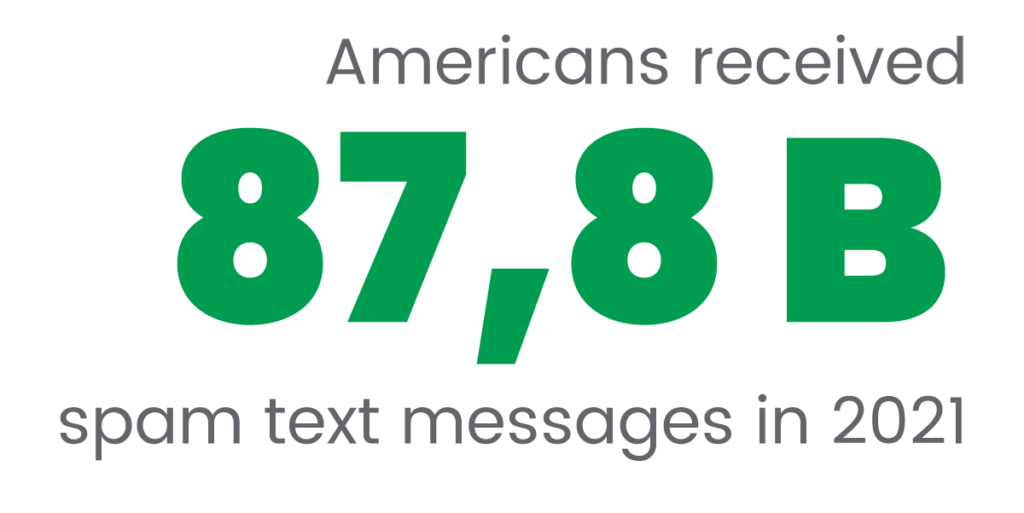
By comparison, in August of 2022, 10.89 billion spam texts were sent, with an individual receiving an average of 41 spam texts a month.

Check out how to avoid scam likely for your business numbers.
To improve the trust and quality of the messaging ecosystem, A2P 10DLC was introduced by carriers (AT&T, Verizon, T-Mobile, etc.) to protect mobile users from spam and unsolicited messages sent via long-code phone numbers.
It provides transparency into sender identity and messaging use cases and ensures that recipients consent to receive messages from a business.
A2P 10DLC creates a more verified, secure, and personalized experience for businesses and consumers using SMS as a communication channel.
Up next…A2P 10DLC Vetting.
What is A2P 10DLC Vetting?
During the hiring process, an employer assesses the suitability and credibility of candidates. It takes steps to verify information provided by applicants and evaluate their qualifications.
That process is similar to the A2P 10DLC vetting.
A2P 10DLC vetting involves verifying the identity and use cases of businesses and organizations who want to send A2P messages using 10DLC numbers.
The goal is to improve the trust and quality of the messaging ecosystem, reducing spam, fraud, and unwanted messaging.

It consists of two main components:
- Brand registration: You provide information about who sends messages to establish legitimacy with carriers. Depending on your customer type, business size, and traffic volume, different types of brand registration are available to you.
- Campaign registration: You need to provide information about how end-users can opt-in/out of your campaign(s) and receive help. Also, describe the purpose of your messages. Depending on your use case type, there are different types of campaign registration.
Guidelines and examples of A2P 10 DLC campaign registration
Here are some guidelines that will help your campaigns when submitting for approval.
- Ensure consistency in brand, website, and sample messages.
For instance: If your brand name is Shelby, your website is www.shelby.com, but your sample messages say, “Here’s your discount code. Claim it here www.annadellxx.com”.
Your campaign will be rejected.
- Your sample messages and use cases should align.
For instance: If you register a marketing campaign, but sample messages say, “Here’s your one-time passcode: ******,” your campaign will be rejected.
- Have a consistent company name and email domain.
- Before sending any messages, ensure that the brand you have registered is the same one you are sending the message for.
- Submit real and functioning websites.
- Do ensure that recipients opted-in.
For instance: If your text messages suggest that the recipient opted-in appropriately, but your message says, “Hi, do you live on Elm Street? Then you are in luck for this week’s promo…”. Your campaign will be rejected.
- Have an opt-out language in at least one of your sample messages.
Check out: 10 Easy-to-Use SMS Marketing Best Practices for SMBs
All messaging providers that handle A2P Campaigns must go through a vetting process, and fees are associated with registering campaigns.
So,
What are the Benefits of A2P 10DLC?
There are several benefits for businesses and the messaging ecosystem as a whole. Here are some key advantages:
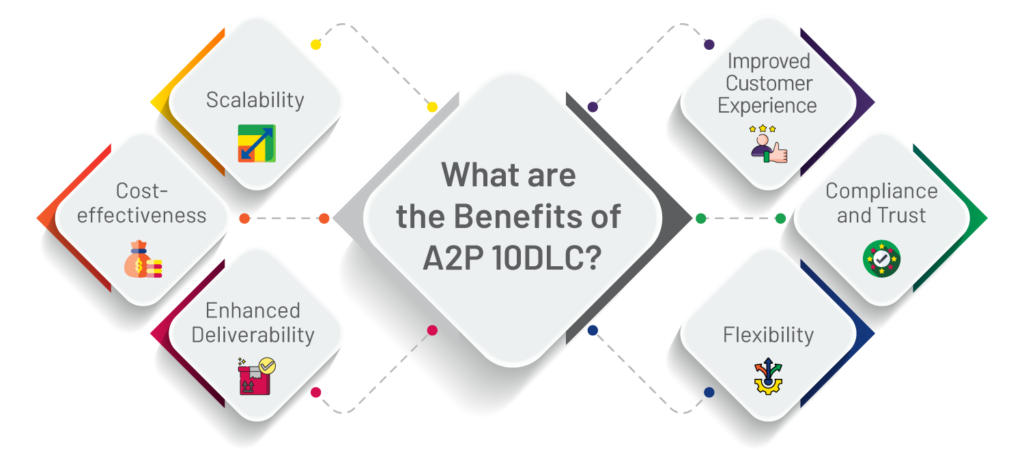
Scalability
Businesses can send high volumes of automated SMS messages using regular 10-digit long codes. This provides greater scalability compared to shortcodes.
Also, your business can efficiently reach a larger audience without facing the constraints of short code availability.
Cost-effectiveness
Compared to shortcodes, long codes are typically less expensive when sending A2P messages.
Long codes are a cost-effective solution for businesses, especially SMBs, because they are simple to use and have fewer setup and maintenance costs.
Enhanced Deliverability
Using A2P 10DLC can enhance the deliverability of your messages. Unlike short codes, long codes are linked to personal phone numbers, which are more reliable and trusted.
Therefore, messages sent through A2P 10DLC are less likely to be filtered out or marked as spam, resulting in a higher message delivery success rate.
Improved Customer Experience
Your business can create a more familiar and trustworthy customer experience using regular phone numbers for A2P messaging.
This increases the likelihood of recipients recognizing and engaging with messages from recognizable phone numbers, resulting in higher open rates and greater customer satisfaction.
Compliance and Trust
Ensuring A2P compliance with 10DLC helps businesses follow industry regulations and guidelines. This builds trust with carriers and reduces the risk of messages being blocked or filtered.
Compliance also fights against spam, fraud, and unwanted messages, creating a more dependable and secure messaging environment for businesses and consumers.
Check out: TCPA Compliance Checklist: 8 Things You Need To Know
Flexibility
A2P 10DLC allows businesses to send different types of messages to customers.
These messages can range from marketing notifications to transactional alerts, appointment reminders, and customer support messages. A2P 10DLC can be used for various communication purposes, helping businesses improve customer engagement strategies.
How to Register For A2P 10DLC
A2P 10DLC registration is crucial for commercial texters to comply with FCC and carrier regulations.
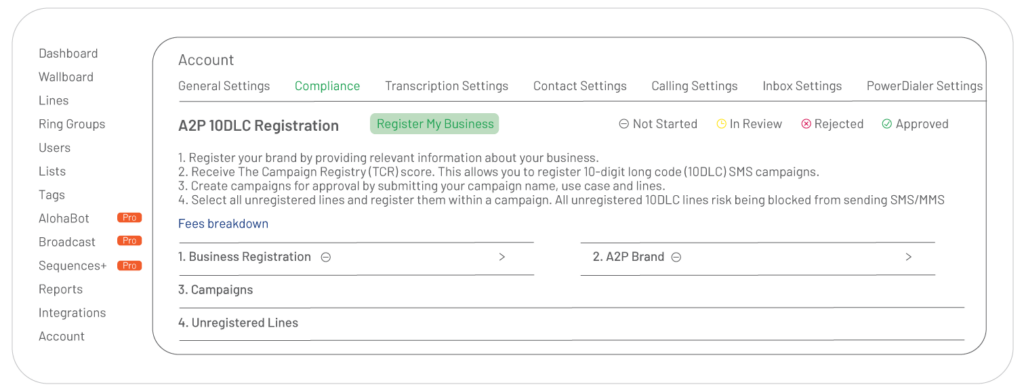
Listed here are the general requirements to secure an A2P 10DLC registration. However, if you need to start immediately, you can visit here for a step-by-step guide.
Identify the Registration Authority
Determine the appropriate registration authority or mobile network operator for A2P 10DLC registration.
Aloware can help with your A2P 10DLC registration. Other companies such as Twilio, Bandwidth, and Infobip are also options.
Gather Required Information
Ensure you have all the required information and documentation. This includes details about your business, such as its name, address, contact information, and tax identification numbers.
Additionally, you may need to provide information about how you plan to use A2P messaging, your expected message volumes, and use cases.
Verification and Validation
You’ll need to submit documents like business licenses, tax certificates, or proof of authorization to send messages on behalf of your business or clients.
Additionally, the registration authority may perform background checks to confirm the authenticity of your business.
Pay Registration Fees
To register for A2P 10DLC, there is a fee that you need to pay.
Be sure to check the applicable fees and follow the instructions given by the registration authority to make the payment.
Compliance and Agreement
Before proceeding, please carefully review and accept the terms, conditions, and compliance guidelines provided by the registration authority or mobile network operator.
These requirements may involve following anti-spam regulations, managing consent, and adhering to usage limitations.
Await Approval
Once you’ve submitted your registration application and met all the requirements, you’ll need to wait for the registration authority to review and approve it.
Please note that the length of the approval process might vary.
Aloware provides a step-by-step guide that will walk you through registering for A2P 10DLC, ensuring you can engage in commercial text messaging while maintaining compliance and trust with your audience.
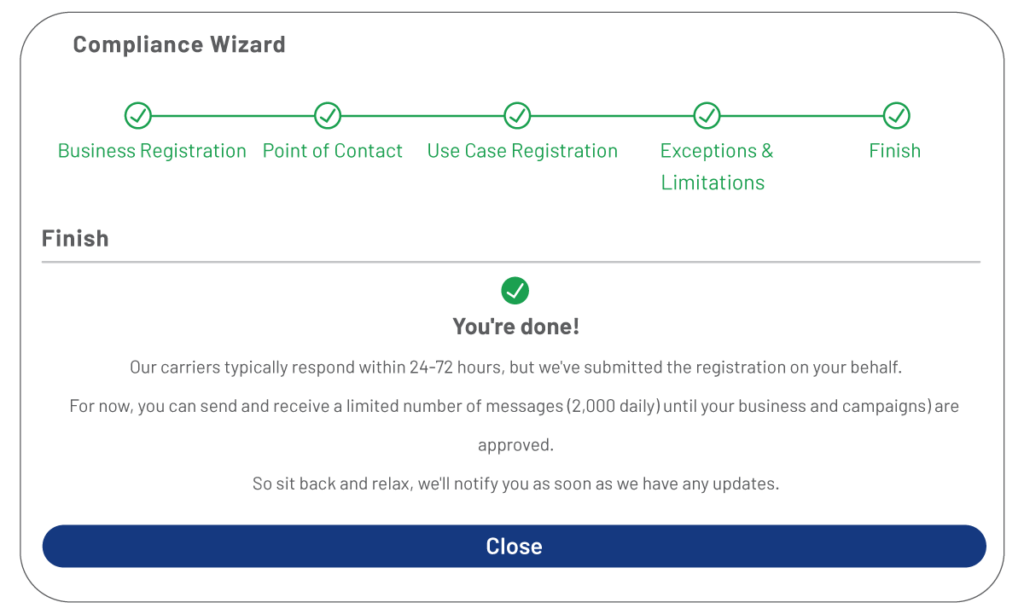
Check out: Essential A2P 10DLC Compliance Requirements for Businesses.
What fees are associated with the A2P 10DLC service?
When registering for A2P 10DLC, you should be aware of two types of fees:
- Registration fees,
- Per-message carrier fees.
These fees are charged by carriers and are a standard part of the A2P 10DLC system.
You must pay registration fees once your US A2P Brand and A2P Use Case are approved.
Carriers also charge carrier fees for A2P 10DLC messages sent to network users.
Typically, fees are charged for each outgoing SMS or MMS message. T-Mobile (including Sprint) also charges fees for incoming SMS and MMS.
Please see below for a full breakdown of the fees associated with A2P 10DLC as listed by Twilio.
Registration Fees:
- US A2P Sole Proprietor Brand registration fee: $4 one-time registration fee at the time of approval (no Secondary Vetting for A2P 10DLC)
- US A2P Low Volume Standard Brand registration fee: $4 one-time registration fee at the time of approval (no Secondary Vetting for A2P 10DLC)
- US A2P Standard Brand registration fee: $44 one-time registration fee at the time of approval (includes Secondary Vetting for A2P 10DLC)
- US A2P Campaign use case registration fees: $15 one-time registration fee at the time of vetting.
List of campaign use case types
When registration is approved, US A2P will provide the following standard campaign use cases found in the table below.
| Campaign use case(registered on your Messaging Service) | Description |
| 2FA | Any authentication or account verification, such as OTP |
| Account Notifications | Notifications about the status of an account or related to being a part of an account |
| Customer Care | Support, account management, and other avenues of customer interaction |
| Delivery Notifications | Information about the status of a delivery |
| Fraud Alert Messaging | Messaging about potentially fraudulent activity, such as spending alerts |
| Higher Education | Informational campaigns from colleges, universities, and other educational institutions. |
| Marketing | Information about promotions, including sales and limited-time offers. |
| Mixed | This campaign can be used for multiple purposes, including customer care and delivery notifications. However, it’s important to note that if you mix different use cases, the campaign may have lower efficiency and cost more per message. It’s also worth mentioning that brands with low volume can still benefit from the low-volume mixed-use case explained below. |
| Polling and voting | For conducting polling and voting, such as customer surveys. Not for political use. |
| Public Service Announcement | PSAs to raise audience awareness about a given topic |
| Security Alert | Notification of a compromised system (software or hardware related) |
Special A2P 10DLC campaign types
| Campaign Type | Use |
| Agents and Franchises | For brands with multiple agents, franchises, or offices that need distinct local phone numbers for each. |
| Carrier Exemptions | Exempt campaigns designated by carriers |
| Charity | Messages received from registered charities, specifically those with a 5013C status, but not including religious organizations. |
| Emergency | Messages promoting public safety and health following a natural disaster, conflict, or any other emergency situation |
| K-12 Education | Messaging for K-12 educational institutions and distance learning centers, but not post-secondary school |
| Political Campaigns | This messaging is only meant to influence the decision-making of a certain group and is restricted to pre-vetted Federal campaigns and select organizations. |
| Proxy | Peer-to-peer, app-based messaging with proxy/pooled numbers |
| Social | Sending messages within or between exclusive groups, such as alerts for influencers. |
| Sole Proprietor | Sole Proprietors are individuals with a billing address but without an EIN / Tax ID |
| Sweepstake | Messaging for or around sweepstakes and contests |
| Platform Free Trial | Free trial messaging |
| UCaaS High-Volume | Unified Communications as a service |
| UCaaS Low-Volume | Unified Communications as a service |
What is the A2P 10DLC Trust score?
The Trust Score is a score assigned during your brand registration with The Campaign Registry (TCR). The third party that administers the US wireless carriers’ new registration system for Application-to-Person (A2P) messaging via 10-digit long code (10DLC) phone numbers.
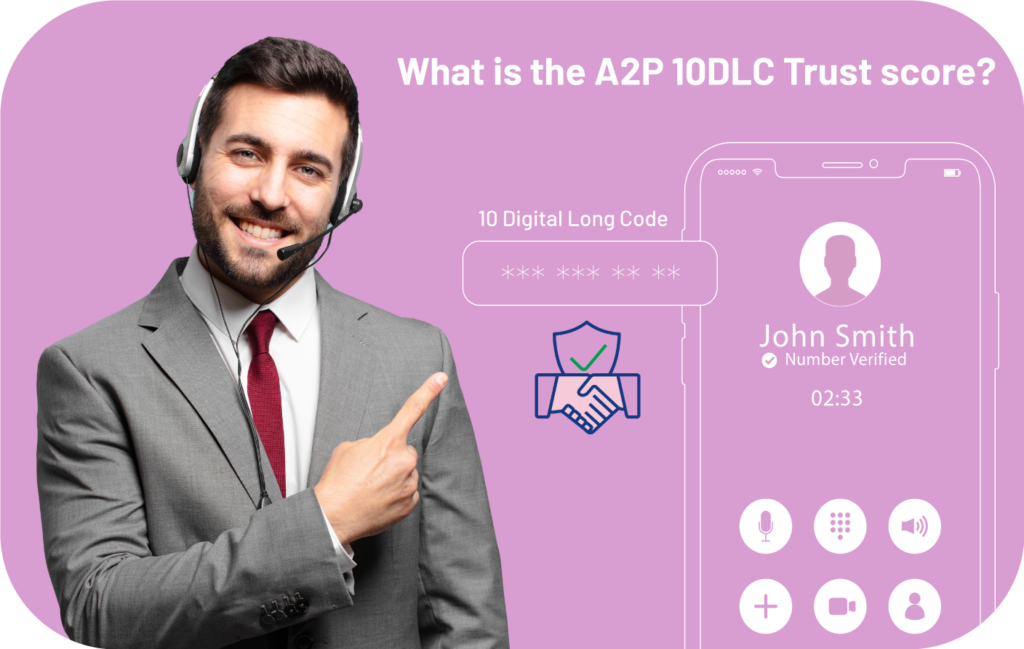
After completing your registration, a trust score is assigned to your brand from 0 to 100.
The Trust Score considers several factors, including your business information, industry, and use case.
Following registration best practices, like using a valid EIN, providing an accurate business address, and choosing the appropriate use case for your campaigns, can also impact your Trust Score.
If you followed the guidelines but your Trust Score remains low, contact your service provider. as the number of messages allowed for each of your Campaign use cases is decided by your trust score.
A2P 10DLC Trust Scores and messaging throughput
| Trust Score | Total Messages Per Day | Total Messages Per Second (MPS) | AT&T Messages Per Second (MPS) | T-Mobile Messages Per Second (MPS) | Verizon Messages Per Second (MPS) |
| 86 – 100 | 10000+ | 180 | 60 | 60 | 60 |
| 66 – 85 | 5000+ | 30 | 10 | 10 | 10 |
| 26 – 65 | 3000+ | 3 | 1 | 1 | 1 |
| 15 – 25(Low Volume Mixed Campaign) | 1000+ | 2.2 | 0.2 (12 segments per minute)** | 1 | 1 |
Are there Penalties for not registering for A2P 10DLC?
To avoid facing legal consequences or penalties, it is crucial to comprehend and adhere to the guidelines. Failure to register for A2P 10DLC could result in possible penalties, such as those listed below.
Messaging Filtering or Blocking
If you send messages from unregistered A2P 10DLC sources, mobile network operators might use filters or block them.
As a result, your messages may not reach the people you intended to send them to.
Service Suspension,
Mobile network operators may stop your A2P messaging services if your business is non-compliant.
This can cause problems with your messaging operations and make it harder to communicate with your customers.
Fines and Monetary Penalties
Regulatory bodies or authorities may impose fines or monetary penalties on businesses found to be non-compliant with A2P 10DLC registration requirements.
The fines can vary based on the severity of the violation and the regulations in place.
Legal Consequences
Failure to comply with A2P 10DLC regulations may result in legal action, including lawsuits or regulatory proceedings initiated by affected parties or regulatory authorities.
This can lead to increased financial liabilities and reputational harm to your business.
So, What Next?
Adhering to A2P 10DLC compliance is vital for maintaining the integrity, reliability, and trustworthiness of A2P SMS communication. Following the rules and guidelines set by A2P 10DLC helps your businesses maintain high standards for messaging practices, reduce spam and fraud risks, and provide positive recipient experiences.
Would you like to get started with A2P 10DLC registration? We can get you started.
